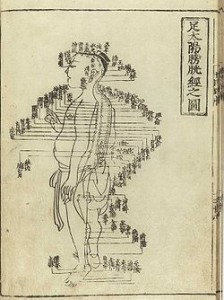INTRO TO ACUPUNCTURE TREATMENT

> Deutsche Akademie für Akupunktur <
Acupuncture is the procedure of inserting and manipulating filiform needles into various points on the body to relieve pain or for therapeutic purposes.The word acupuncture comes from the Latin acus, „needle“, and pungere, „to prick“. In Standard Mandarin, 針砭 (zhÄ�n biÄ�n) (a related word, 針灸 (zhÄ�n jiǔ), refers to acupuncture together with moxibustion).According to traditional Chinese medicine, acupuncture points are situated on meridians along which qi (a „life energy“), flows. Modern acupuncture texts present them as ideas that are useful in clinical practice and continue to inform the practice of acupuncture, but there is no evidence to support their existence and they have not been reconciled with contemporary knowledge about biology, physics or chemistry.
Moxibustion (Chinese: 灸; pinyin: jiǔ) is a traditional Chinese medicine therapy using moxa, or mugwort herb. It plays an important role in the traditional medical systems of China, Japan, Korea, Vietnam, Tibet, and Mongolia. Suppliers usually age the mugwort and grind it up to a fluff; practitioners burn the fluff or process it further into a stick that resembles a (non-smokable) cigar. They can use it indirectly, with acupuncture needles, or sometimes burn it on a patient’s skin.
An Introduction to Different Types of Acupuncture Treatment:
Perhaps the first image that comes to mind of an acupuncture patient is that of a person sitting there with any number of needles stuck into their skin at particular points on their body such as the ear or wrist. In fact, this picture is a pretty accurate image of acupuncture treatment, with these sessions lasting anywhere from a few seconds to half an hour or more depending on the problem being treated. The needles are usually inserted just deep enough into the skin to hold them firmly in position, although they are inserted deeper if the symptoms being treated require it. Sometimes a twirling motion is used to insert the needles, which may on some occasions be warmed before insertion or be heated whilst they are under the skin. In most instances the insertion, manipulation or removal of the acupuncture needle causes no pain other than the very occasional slight twinge. If anything, the patient tends to feel more relaxed during the session, often experiencing a warm rush of energy. There are patients who will feel no immediate effects but instead notice changes over a more gradual period of several weeks.
Some varieties of acupuncture do not rely on needles. The thinking behind these methods, however, is exactly the same as conventional acupuncture technique and focusses principally on a knowledge of acupuncture points, the make up of the human body and an understanding of the importance of proper energy flow. The essential difference is that rather than a needle some other method is used to trigger the acupuncture point. For example, in sonopuncture, a device producing sound waves is applied to the acupuncture point; there are practitioners who use vibrating devices such as tuning forks to achieve similar results. Although these practices are being used increasingly there is significantly less documentation as to how effective they are compared to traditional needle based acupuncture.
The use of low voltage electric currents applied to acupuncture points has been in use since the mid 1950s. Sometimes this method is combined with that of the insertion of a needle, on other occasions a small wire connected to the current is simply placed on the skin, resulting in a light tingling sensation. In spite of being independently studied in both Europe and the US in the 1930s and 1940s western medicine seems to have subsequently lost interest in investigating its benefits any further.
Acupressure is perhaps the best known of the variations of traditional acupuncture. In this method no instruments are used other than the pressing of fingers to the acupuncture point. It can also be readily combined with other massage techniques such as shiatsu. It has the advantage of being relatively easy for even the layman to perform, aided by diagrams of pressure points on the hands and feet for example. It goes without saying, however, that although these diagrams can be helpful for relieving minor symptoms, a professional acupuncture practitioner will have a full and more effective understanding of the entire acupuncture system which goes far beyond simply knowing where the acupuncture points are found.
Acupuncture today embraces the use of many different instruments. The application of heat remains the most traditional choice amongst the alternatives, although approaches as varied as friction, magnets, suction and even laser beams are also used. Acupuncture is a therapy which has clearly stood the test of time and with is enormous adaptability and effective results, is the perfect compliment/alternative to western medicine.
> Meet Acupuncture Groups and Studies at facebook <
> Meet Moxubustion Groups and Alternative Medicine at facebook <
Comments are closed.